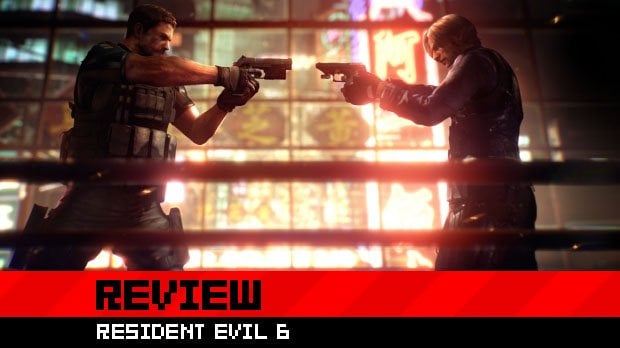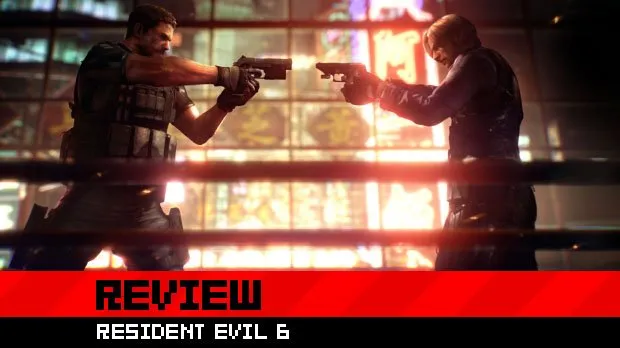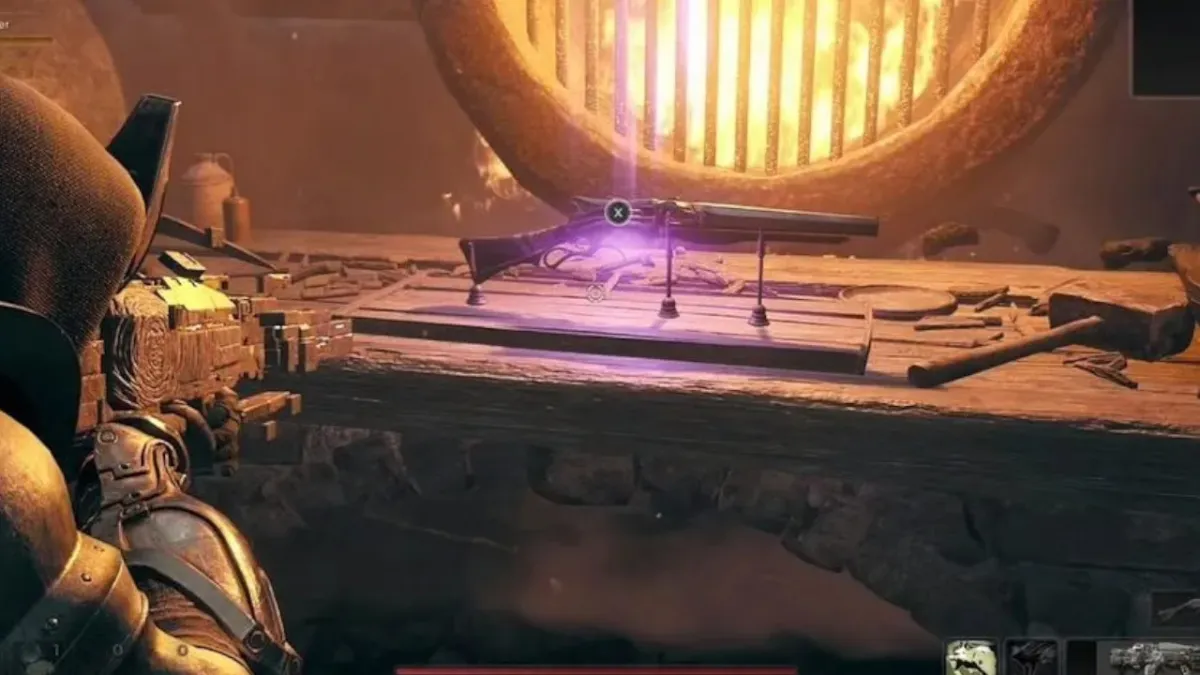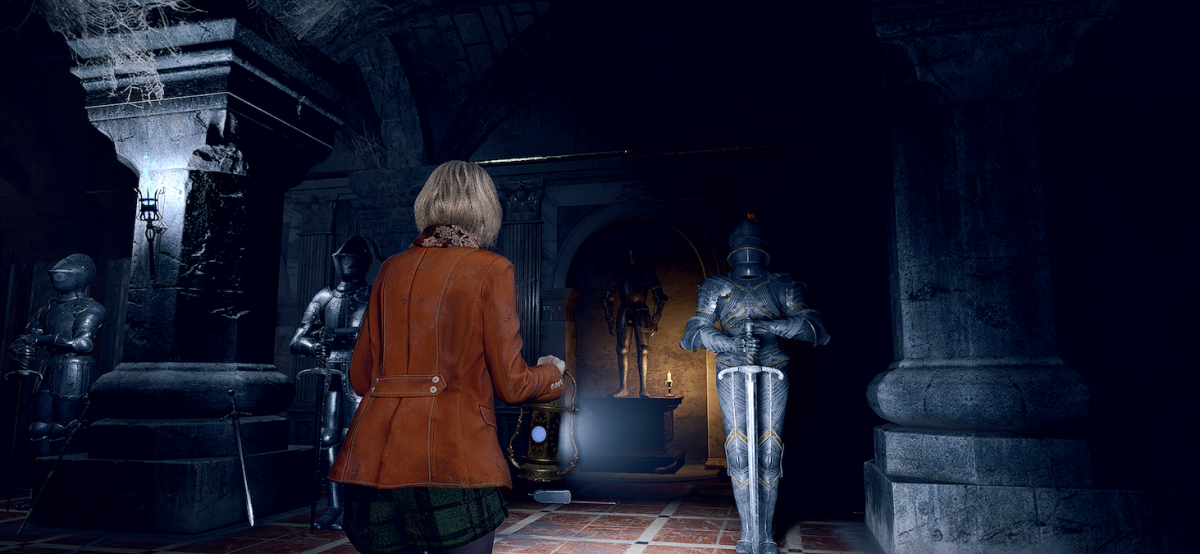Resident QTE-vil
When you first start playing Resident Evil 6, it looks like it might almost be a joke, perhaps a stealthy parody of big-budget action videogames. It begins in the aftermath of an explosion, seen from a first-person perspective, and the entire introductory sequence is littered with quick-time events. There is a helicopter.
At first, things look bleak. Is this what Capcom’s legendary survival horror series has become? A bubbling mass of cliches, a tribute to everything vapid and faintly ridiculous about so-called “AAA” game development? Nothing but shallow Hollywood action sequences and glorified, barely interactive cutscenes? Is this Resident Evil now?
That’s merely what it looks like when you first start playing.
The full experience is something slightly less appealing than that.

Resident Evil 6 (PC, PlayStation 3, Xbox 360 [reviewed])
Developer: Capcom
Publisher: Capcom
Release: October 2, 2012
MSRP: $59.99
Resident Evil 6 is a Michael Bay movie. There’s really no more polite a way to put it. Stuffed to the gills with bombastic action segments, car chases, and relentless chaos, Capcom has abandoned any pretense of the survival horror genre and embraced a world of skin-deep Hollywood audacity. Listlessly wallowing in the depthless waters of homogeneity, Resident Evil 6 is a coward of a game, afraid to make its own individual mark in the industry and cravenly subscribing itself to every overplayed trope in the book.
This review, however, is not one big complaint about the jettison of survival horror, for if Resident Evil 6 was at least a refreshing and provocative action game, it might have gotten away with it. Sadly, this is not the case. If one were to remove the legacy of the Resident Evil name and release this as an original IP, it would occupy shelf space somewhere between Quantum Theory and Inversion, those built-on-a-budget “me too” shooters that follow unambitiously in the footsteps of Gears of War and (ironically) Resident Evil 4, copying the most popular games on the market in childlike hope that they may enjoy the same success. Resident Evil 6 is an incessant, monotonous slog from one room of shambling opponents to the next, providing cheap gun battles for people who truly have given up on enjoying something better.
There are four campaigns revolving around the characters of Leon, Sherry, Chris, and Ada Wong, three of which feature support characters in order to focus solely on cooperative play. What this translates to within the confines of gameplay is a series of doors blocking progress through each chapter, requiring both players to press a button in the same location before watching a canned animation of said door being kicked open. You know the type of system — it’s in every slapdash co-op game that’s can’t think of an original way to make players work together.
There are a few cursory co-op “puzzles” thrown into the mix that mostly consist of the “one person turns a handle while the other person walks through a gate” variety, but the implementation is half-hearted at best. Most cooperative sequences are simple blockades erected to create the illusion that you actually need the second character (that nobody wants to play as because they’re both new and uninteresting) when really you’re just tolerating a burden shunted guilelessly into the storyline so some marketing department has an obligatory feature for the back of the game box.
RE6‘s hackneyed co-op design is exemplified when playing through a quick-time event that only pertains to one character, such as the one with Leon and his rent-a-partner sitting in a car. Leon has to perform a whole bunch of QTEs to get the car started while the other player just sits there in a first-person view, watching. Yes, Resident Evil 6 actually decided to make a player sit and watch someone else play (if it can be called playing), because nobody could be bothered to think up something for both users to do. There are other moments like this littered throughout, where one player has something to do and the other is meant to stand there like a brass monkey.

Outside of these vacuous examples of pantomime cooperation, you’re basically running from point A to point B, stopping to shoot either zombies or J’avo depending on which campaign you’ve chosen. The difference between the two enemy types is mostly in speed, as the zombies featured in RE6 are more like slower versions of the Ganado in RE4, while the J’avo are faster, rifle-toting versions. Both enemy types can wield weapons, and both enemy types have the potential to mutate into highly annoying variants in such a way that one feels punished for daring to attack them.
The zombies may become Crimson Heads, which now leap ludicrous distances, move faster than you can target them, and take more time than is enjoyable to put down. The J’avo feature differing mutations depending on which of their limbs have been hurt, and can transform into all sorts of creatures such as grasshopper-legged leapers or claw-armed melee attackers. It’s certainly an interesting idea, though it does reduce the fun of taking out enemy limbs, since it no longer offers any tactical advantage and just makes a fight tougher.
The biggest difference between the campaigns is the way in which they waste the player’s time. In Leon’s story, this is achieved by having zombies regularly grab the character to initiate a brainless, stick-waggling QTE. With Chris and Sherry, we have gunfire that knocks them to the ground with such laughable regularity that you’d be forgiven for thinking the drunken physics from Grand Theft Auto IV had made an unscheduled return. Naturally, recovery animations often see the character get back up just in time to eat another attack — because that worked so well in Lost Planet. Bear in mind none of this makes the game very difficult — especially with a partner, you ought to have no problem clearing campaigns — it just makes it a pain in the backside.

There are a few other different enemies, such as dogs, insect mutants, and undead that scream to attract more zombies, but we’ve seen these ideas before in all sorts of run-of-the-mill games. The played-out enemy types are indicative of Resident Evil 6‘s biggest problem — it’s ordinary to an almost extraordinary degree. Combat isn’t even as fast-paced and varied as the critically mauled Operation Raccoon City, from which this game seems to derive most of its inspiration. Not to continue talking about Michael Bay but, like his films, RE6‘s fast pace and big setpieces are merely aesthetic, with no real energy or punch behind them. It looks impressive for the first few minutes, but then the explosions just keep on exploding with nary a change in pace. Never does the game pull out something that might surprise the player, not once is anything ever shocking. It’s simply combat-by-numbers, and RE6 is happy to be this way until the credits roll.
The lack of pacing really hurts one’s enthusiasm for the campaigns. In previous games, there was always a sense of build, of things starting slow, growing to big confrontations, and then setting the dial back to build towards something even larger. From the moment the first thing blows up in Resident Evil 6, it maintains the same level of insipid action, leaving itself no room to ramp up or scale back. Compared to past games, there’s no sense of character, nothing to remember. It’s just a cavalcade of banal skirmishes and scenarios ripped liberally from other modern videogames.
You remember the war-like scenario near the end of Resident Evil 4, where the ally with the helicopter arrives to help you take out a small army of military-level Ganado? That was a fantastic moment, because it had been built to over the course of a gradually evolving game. It felt inspiring to be thrust into a warzone after such a tense ride there. Resident Evil 6 tries to start with that level of action, and stays there. Imagine if the soldier area of Resident Evil 4 had been the whole game, with nothing leading to it and nothing changing for the course of the adventure — in an industry where half a dozen competing titles were doing the same thing, no less. That is the core of the latest Resi installment.

At its base line, RE6 inspires indifference — but it gets worse. If Resident Evil 6 had stopped at simply being a mediocre shooter, that may not have been so bad. It at least would have been worth maybe a weekend’s forgettable rental. However, in spite of copying several years’ worth of third-person shooters, Capcom makes a series of embarrassing mistakes that drag the experience from mundane to beleaguering. Aside from the camera, the cover system is an absolute joke, forcing characters to snap against walls automatically whenever a firearm is drawn, regardless of the player’s desire. Firing from cover is horrendously awkward, since the camera once again is unable to provide an adequate angle or distance to ensure accurate aiming. It’s a system that, by design, causes only problems with zero strategic benefit.
As for dodging, it wasn’t enough to have a simple combat roll. Instead, one has to aim a weapon, then push on the stick while hitting the sprint button. If the weapon remains readied, the character will lie on the floor like an idiot, only getting up when buttons are released. It’s an awkward thing to get used to in the heat of battle, especially as the whole “floor combat” thing is inefficient and mostly leaves players vulnerable. All we needed was a combat roll. The kind of thing games have done perfectly well for years. It’s pitiful that Resident Evil 6 can’t even do that right.

Health recovery has also been tampered with, the classic herb system now replaced with tablets. While herbs are still collected, they’re useless until the player goes into the menu and mixes them into these tablets, which are swallowed with a quick button press. One pill restores one block of health, and in order to replenish several blocks at once, the tablet button must be pressed the corresponding number of times. Why? Why was the simple idea of using a health item dragged out into several more contrived steps? This enhances the game in no way whatsoever, it’s just convoluted for the sake of being convoluted. Of all the things to alter, I cannot fathom who in their right mind would have the hubris to try and reinvent the working method of health restoration with all the elegance of a train full of rhinos.
One thing that has been preserved from the series’ horror roots is ammunition — there’s not enough of it. Even though the game has devolved to the point where it’s a glorified shooting gallery, the decision to keep ammo restricted comes off like a cruel — albeit ironically hilarious — prank. Characters start with multiple guns, but bullets are sparse, especially when crates and enemies spew out “action points” (used to buy some paltry upgrades) and other useless items even when guns are running empty. This potentially leads to some horrible moments in rooms where a number of enemies must be killed before progressing, and there’s nothing to kill them with from a safe distance. Fortunately, the melee attacks are overpowered enough to kick the heads off two zombies with one sweep. Unfortunately, the game needs melee attacks that are so overpowered they can kick the heads off two zombies with one sweep.
That is, of course, if the camera isn’t positioned in such a way that the player doesn’t end up just kicking at the air next to the zombie instead of the zombie itself. If you haven’t gathered by now, the camera is deplorable — along with so many other things. What else could I talk about? The fact the game doesn’t pause if your controller disconnects? The sprinting sections that play like a “runner” style mobile game, but less interesting? Reliance on the whole “character talks into earpiece and is unable to walk properly or pick up the items next to them for no good reason” schtick? Blatantly placed, predictable corpses that you know are zombies but can’t touch until the game arbitrarily decides to wake them up? None of it’s needed, none of it adds anything of value. It only ever gets on one’s nerves.

The RE6 experience is one of constant struggle, and not in the inspiring, challenging way. I feel like the game itself is constantly trying to stop its players from having fun. Between the ammo restrictions, the broken camera, the awful cover system, and the grinding incessancy of the soporific shooting, it’s a chore to stay invested in the thing. It’s actively repulsive, doing its level best to turn the player away, and ultimately offering nothing to reward anybody for sticking around. There are no good boss fights, so dull they are that I can barely remember them, and it’s not like the cheesy “villain wants to destroy the world because of reasons” story is interesting enough to encourage conclusion. The upgrades players can attain are hardly noticeable in the game — especially the “find more ammo” ability which seemed to have no reliable impact on the amount of ammo I actually found. Every new hill climbed in Resident Evil 6 offers a radial view across little more than a sea of deeper disappointment.

If I had to say something positive, I’d say the ever-present Mercenaries mode still manages to squeeze some enjoyment out of an increasingly dry concept. The combat is at least more engaging when there’s additional ammo on offer and all pretense of plot or importance has been stripped away. I also love the idea of Agent Hunt, a feature in which players can invade other games online as enemy creatures. I just wish this feature were in a better game, and by that I mean it is — you can just play Dark Souls if you want to see this option married to a far superior product.
I’d really struggle to say anything nice about the presentation. Character models are simplistic while the animation is archaic and lifeless in comparison to most modern games of comparable budget. Save for a few early parts of Leon’s campaign, the environments are sparse and boring, while the menus are the only visually remarkable element. Remarkable, but totally style-over-utility (especially since using menus won’t pause the game, even in solo play). The art direction lacks any sense of vibrancy, with most monsters filling stereotypical roles –monster with tentacle, monster with claw arm, fat zombie, fast zombie etc. — and a dull color scheme that makes things look more drab than eerie.

When Resident Evil 4 first crashed into the market, it shook up the action genre and inspired years of pretenders that helped evolve the industry. It’s saddening to see a sequel to that game among the lower rung of hopeless followers, content no longer to lead but to follow like a starving dog after a trail of meat scraps. Resident Evil now lingers far behind, set back by the kind of rookie mistakes reserved for brand new games rather than the sixth installment of a series that should know better. It tows the line in terms of combat, structure, and pacing, only attempting “innovation” in areas that didn’t need innovating, and managing to make a pig’s ear of every single attempt. Its cover system has no place in a game made by professionals. The inadequate ability for players to defend themselves from attacks is maddening, and the unhelpful camera (that the enemies exploit for cheap hits) can only be described as disgusting. Budget games have done better than this.
It’s bad enough that the game — at its very best — is so pedestrian, but to screw up in areas that even third-rate shooters manage to get right is something Capcom should find degrading. It’s not enough to say that Resident Evil 6 is poor as a Resident Evil game. That alone implies there could be a quality experience if fans can get past their preconceptions and feelings of betrayal. No, Resident Evil 6 is poor by the standards of any game, not just the high ones set by its own legacy. This is unexceptional tripe that becomes insulting once the woeful missteps come into play. Resident Evil 6 is not just a step back for the series, it’s a step back for commonplace, unassuming action-shooters.
If any consistently good thing can be said of Resident Evil 6, it’s that it has made Paul W.S. Anderson’s film adaptations look like fine works of art in comparison.





